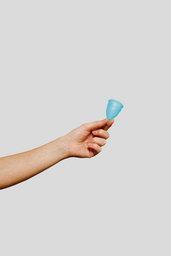Menstrual cups were introduced in the 1930s by Leona Chalmers in the United States, in the form of an uncomfortable rubber cup. As menstruation has been a taboo for several centuries, her product was unsuccessful. But as the world has begun to change and the conversation around periods has opened up, the menstrual cup has become a revolutionary device.
The percentage of women around the world using them is at around 75%. There are many contributing factors relating to the increase of usage. The most notable factors include economic and health reasons and the environmental impact.
Menstrual cups come in two different sizes. The size you choose depends on your flow, your age, if you have given birth and the position of your cervix. Any doctor can help potential users decide which size is best for them.
Reusable menstrual cups are eco-friendly and reduce waste contribution to the environment. Many menstrual cups can be used for up to ten years. They are typically made from medical-grade silicone and can be easily washed and reused. They hold up to two ounces of menstrual flow. In contrast to this, the average tampon can only hold up to a third of an ounce.
According to Organicup, an individual uses up to 11,000 disposable pads and/or tampons in their lifetime. It is estimated that it takes about 500 years for pads and tampons to degrade. It has been reported by the Women’s Environmental Network that annually 400 million pounds of tampons, tampon applicators and sanitary pads end up in landfills.
Many health experts argue that menstrual cups are a safer alternative to disposable tampons or pads. There are a number of reasons for this. Toxic shock syndrome is a rare bacterial infection that we are all familiar with and is synonymous with tampon usage. This infection comes as a result of the tampon absorbing the blood over a long period of time. Alternatively, the menstrual cup collects blood for up to 10 hours rather than absorbing it thus eliminating the risk of TSS.
According to the World Health Organisation, chemicals such as bleach and dioxin have been found in tampons and sanitary pads. Some dioxins are known to cause cancer in humans. As tampons are placed inside the vagina the chemicals can be absorbed and pass directly into the bloodstream.
In addition to the environmental and health factors that promote the use of a menstrual cup, the economic advantage is quite substantial. On average, menstrual cups range from 20-30 euro and can be used for up to 10 years. A box of tampax pearl costs 4.99. Annually costing users about 60 euro. If a woman is fertile for up to 35 years, this will cost her an average of 2,100 euro, if using tampons alone. Many women use both tampons and pads depending on their menstrual flow. By using 3-4 menstrual cups, a woman will save approximately 2,000 euro on disposable products in her lifetime.
These are just three examples of the benefit of switching to the menstrual cup. Instead of panicking and rushing to the nearest chemist or supermarket when your period arrives unexpectedly, the compact menstrual cup can be kept in your handbag all year long. Although the impact of one woman’s shift to the menstrual cup may not change the environmental impact drastically, every little helps.



